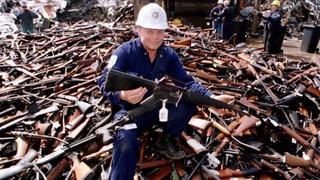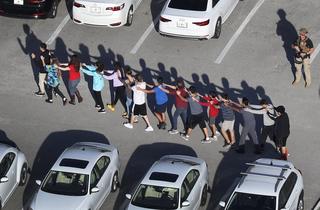Gun violence remains one of the most vexing issues in the United States.
Since just 1968, more Americans have died at the barrel of a gun in civilian society than the sum total of American war dead since the War of Independence. The vast majority of these civilian deaths are suicides and homicides, but it is mass-shootings, particularly those at schools, that galvanise recent debate.
When these tragic events unfold, there is an inevitable chorus of American and international voices asking ‘why does nothing get done about gun control?’ The question that often follows is, 'are Australia's gun laws the solution for the United States'?
At the time of Australia’s watershed moment on gun reform in 1996, then Prime Minister John Howard was, like Donald Trump, a relatively new and staunchly conservative leader. But unlike President Trump’s reaction to several mass-shootings, when 28-year-old Martin Bryant used a semi-automatic rifle to kill 35 people and injure 28 more in the Australian town of Port Arthur, the reaction from the Australian leader was resolute.
Despite the prime minister’s conservative leanings, an entrenched gun culture and a coalition with the country’s rural representative party, the Howard government passed strict new laws, called the National Firearms Agreement (NFA).
Although it is tempting to point at Australia as a prescription to the gun problem in the United States, there are resounding differences between the two countries that inhibit this.
This enacted a near total prohibition on the ownership, possession, sale and importation of all automatic and semi-automatic weapons. It also made the process of buying a gun more difficult with a mandated cool-off period. In a buyback scheme of the now-illegal weapons, 640,000 – or roughly one fifth – of the nation’s guns were destroyed.
After the Howard government’s action in 1996, gun-related deaths dropped significantly – although there remains debate over whether the reforms accelerated the reduction in deaths or merely kept them on a steady downward trend.
By contrast, pro-reform ambitions in the United States are much lower. Even Barack Obama’s doomed reforms only focused on background checks, assault weapons and punitive measures against gun traffickers.
The failure to bring about even small change has given rise to a fatalistic mantra of 'if not after Sandy Hook, when?' following the shooting death of 20 children and six adults at a K-12 school in 2012.
Although it is tempting to point at Australia as a prescription to the gun problem in the United States, there are resounding differences between the two countries that inhibit this.
The shot heard around the world
The right to bear arms was central to the success of the American War of Independence (1775-1783) and enshrined in the Constitution that resulted. This left an indelible mark on the American psyche.
The Second Amendment to the Constitution links guns and the ability to resist tyranny, reading, “A well-regulated militia, being necessary to the security of a free state, the right of the people to keep and bear arms, shall not be infringed”.
Australia’s Constitution is not based in the guarantee of individual rights like speech, assembly, equal protection, and gun ownership, and has a far easier method of amendment than its US counterpart.
Today, the prospect of armed militias being able to overthrow the US government and its military-might seems inane, but it is one that symbolically endures. At least until 2013, more than half of all Americans saw gun rights as a counterbalance to tyranny.
Australia’s Constitution is not based in the guarantee of individual rights like speech, assembly, equal protection, and gun ownership, and has a far easier method of amendment than its US counterpart. To enact Australian-style gun restriction, the US Congress would first have to pass a Constitutional Amendment with a two-thirds majority where it would then have to be approved by 38 state legislatures (3/4s). Alternately, a shift in the US Supreme Court’s interpretation of the 2nd Amendment could allow for much stricter gun control measures to be passed both federally and at the state level, were there the political will to do so.
The result of this divergent history and legal context is that public opinion and gun ownership is markedly different

We the People
In Australia roughly 45 per cent of the population support the current gun laws, and 44 per cent want them to be strengthened. This makes 89 per cent of the population in favour of gun control substantially stricter than in the United States.
Of those who own a gun in the United States, the right to own a firearm is strongly tied to their sense of freedom. According to polling conducted by Pew Research in 2017, roughly three quarters of gun-owners say this right is an essential one – even more than the 67 per cent of gun owners who see protection as a major factor in their gun purchases.
After the Sandy Hook shooting and President Obama’s calls for reform, gun purchases spiked to a record two million per month – more than three times the number of guns melted down in Australia’s first gun buyback.
The entwining of guns and protection is central to the ’good guy with a gun’ theory that suggests if more people were armed they could stop a mass-shooting in its tracks. This can make it overwhelmingly difficult for law enforcement to identify the suspect.
Herein lies another problem: the sheer number of guns in the United States. Because of the ease of buying a gun without a permit in the United States, their total number is difficult to track.
A reputable study conducted in 2013 estimated the number to be between 270 to 310 million. The Pew Research polling from 2017 indicates declining gun-ownership rates amongst individuals over time, but still nearly four in ten Americans say they live in a household with a gun.
To match the scale of Australia’s gun amnesty, roughly 58,000,000 weapons would need to be purchased at an incredible cost to the government. This seems impracticable, especially under a conservative government.
"Guns don’t kill"
One of the most visible differences between the Australian and US contexts is the National Rifle Association (NRA). Their ethos that ‘guns don’t kill people, people kill people’ is one that has gained traction in defence of gun rights.
A commonly touted argument from the pro-reform side is that the pro-gun lobby group has purchased a veto on gun reform by exerting political influence in the lead-up to elections, particularly by writing scorecards on candidates' history of votes and statements on gun control, as well as especially through donations and mobilising many of its more than five million dues-paying members.
Although NRA donations can’t be discounted as a factor in politicians’ decision-making process, the money donated amounts to a tiny fraction of the Republican fundraising apparatus. Across the board, the NRA has spent a considerable $203 million on political activities since 1998, but this pales in comparison to the $1.1 billion donated by Wall Street in the 2016 election cycle alone. Unlike Wall Street, however, the NRA can utlise its millions of dues-paying members to write and call their congresspersons – a tactic that when engaged en massse tends to be particularly effective in swaying undecided legislators.
The views of the Republican base hold a great deal of explanatory power in this respect. Of the Republicans polled by Pew Research in 2017, 66 per cent were in favour of expanding gun rights, by allowing concealed-carry in K-12 schools. Fifty-three per cent were in favour of shortening waiting periods for buying guns legally.
There are, however, areas of consensus between Republicans and Democrats, and these – as well as a groundswell of youth activism – may be where reform starts.

The mass-shooting generation
The response to the February 2018 Stoneman Douglas School shooting has differed markedly to those previous in that the victims have taken control of the fallout.
Students of the school have been incredibly vocal in their demands for reform and have kept the gun debate active in the media for considerably longer than usual. The scheduling of protest marches months in advance ensured this continued.
The private sector has responded. Companies have cut ties with the NRA en-masse, and already Walmart and Dicks, two of the nation’s largest gun retailers, have bowed to the pressure and will circumvent local jurisdictions to lift the minimum age of people they will sell guns to and limit the types of weapons available.
If this mobilisation of future voters and the pressure they bring to bear are to buck the trend and solicit real, legislative change on the hill, it is consensus points that will be at the vanguard.
Both gun owners and non-gun owners strongly agree that people suffering a mental illness (89 per cent) and people on the no-fly list (82 per cent and 84 per cent) should be prevented from purchasing guns. There is also agreement on the issue of background checks, with 77 per cent of gun owners and 87 per cent of non-gun owners agreeing that they need to be extended to include private gun shows. The president too has indicated he is open to reform, banning bump stocks, a modification that allows a semi-automatic rifle to fire continuously.
Although all of these changes would be overwhelmingly positive steps, they wouldn’t nearly constitute ‘Australian-style’ gun reform; but given the legal and political challenges gun control faces in the United States, to expect that would be unreasonable.






